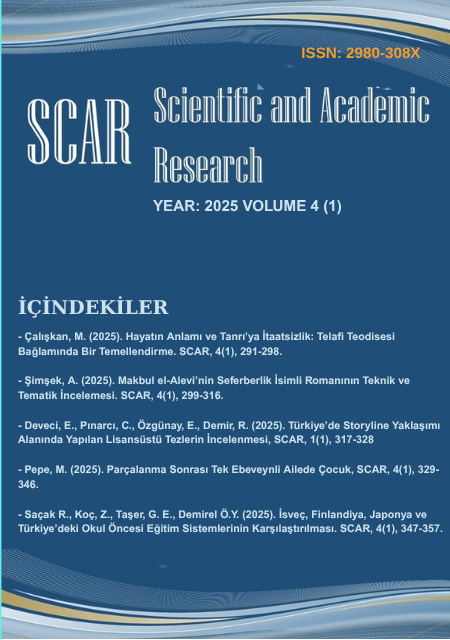The Technical and Thematic Analysis of Makbul el- Alevi’s Novel Seferberlik
The Technical and Thematic Analysis of Makbul el- Alevi’s Novel Seferberlik
Keywords:
Arabic language and Rhetoric, Novel, Seferberlik, Makbul al-Alevi, MedinaAbstract
Makbul al-Alevi’s Seferberlik focuses on the Ottoman Empire’s struggle against Sharif Hussein during World War I. The protagonist, Ziyb, is kidnapped by desert bandits while herding sheep and sold as a slave in Medina. Freed by Sheikh Abdurrahman, Ziyb works for him and witnesses the hardships faced by Medina’s people under Ottoman rule. The novel critically examines decisions made by Fahreddin Pasha during the defense of Medina, such as transferring sacred relics to Istanbul and confiscating provisions, portraying them in a negative light.
The novel accuses Ottoman soldiers of taking bribes and labels the forced migration of Medina’s residents as an occupation. Al-Alevi uses a simple style and eloquent language to draw the reader into the narrative, interpreting historical events through a subjective and ideological lens that portrays the Ottomans as occupiers. The story objectively depicts the characters’ inner lives and the settings, but the author’s ideological emphasis overshadows the artistic quality of the work.
Despite lacking artistic merit, Seferberlik gained recognition in Arab literary awards, showcasing its ideological impact. While the novel emphasizes Arab independence after Ottoman rule, historical realities reveal that British support was driven by imperialist ambitions in Arab lands. This perspective highlights the complexities of the post-Ottoman Arab Middle East and its uncertain future under European dominance.
References
Aktaş, Ş. (1991). Roman Sanatı ve Roman İncelemesine Giriş (2. bs). Akçağ.
Argunşah, H. (2016). Tarih ve Roman. Kesit Yayınları.
Barlak, H. (2016). Fahreddin Paşa’nın Hicaz Cephesinde Bayrak Mücadelesi. Studies Of The Ottoman Domain, 6(11).
Beyoğlu, S. (t.y.). Türk-Arap İlişkilerinin Son Kırılma Noktası: Medine’nin Tahliyesi. Atatürk Araştırma Merkezi Dergisi, 26(78), 425-460.
Can Emir, B. (2019). Rus Edebiyatında Tarihî Roman Üzerine Bir Değerlendirme. Sosyal Bilimler Araştırmaları Dergisi, 14(1), 285-298.
Çetin, N. (2009). Roman Çözümleme Yöntemi (7. bs). Öncü Basımevi.
Demiryürek, M. (2013). Kurgusal Metinlerde İkinci Kişili Anlatıcı ve Bakış Açısı. FSM İlmî Araştırmalar İnsan ve Toplum Dergisi, 2.
Doğan, M. (1994). Büyük Türkçe Sözlük (10. bs). Ülke.
el-Alevi, M. (2011). Senevatü’l-Hub ve’l-Hatîe. el-Müessesetü’l-Arabiyye li’d-Diraseti ve’n-Neşr.
el-Alevi, M. (2017). Fitne Cidde. Dâru’l-Sâkî.
el-Alevi, M. (2019). Seferberlik (1. bs). Dâru’l-Sâkî.
Eminoğlu, A. (2018). Muhammed Hasan Alvân’ın “Mevtun Sağîrun” (Küçük Bir Ölüm) Adlı Romanının Teknik ve Tematik İncelemesi. Necmettin Erbakan Üniversitesi İlahiyat Fakültesi Dergisi, 46, 141-162.
Gürbüz, Ö. (2001). Düşünce ile Tema ve Konu. Kurgu Dergisi, 18, 101-108.
Harmancı, H. (2013). “Abdurrahman Munîf’in el-Escâr ve İğtiyâlu Merzûk Adlı Romanının Teknik Yönden İncelenmesi. Selçuk Üniversitesi Edebiyat Fakültesi Dergisi, 30, 67-96.
Karaca, İ. (2006). Tarihî Romanlarda Mekân-Coğrafya. Türk Dili ve Edebiyatı Dergisi, 34(34), 71-89.
Stevick, P. (1988). Roman Teorisi (S. Kantarcıoğlu, Çev.). Gazi Üniversitesi Basın-Yayın Yüksekokulu Matbaası.
Tekin, M. (2012). Roman Sanatı (11. bs). Ötüken.
Tepebaşılı, F. (2012). Roman İncelemesine Giriş (1. bs). Çizgi Kitabevi.
Yatak, S. (t.y.). Fahreddin Paşa. İçinde Türkiye Diyanet Vakfı İslâm Ansiklopedisi.
Yıldız, A. (2021a). Abdulvehhâb ʿÎsâvî’nin ed-Dîvânu’l-Isbartî İsimli Romanının Teknik ve Tematik İncelemesi. Akif, 51.
Yıldız, A. (2021b). Murîd el-Berğûsî’nin Raeytu Râmallah İsimli Romanının Teknik ve Tematik İncelemesi. Cumhuriyet İlahiyat Dergisi, 21(1), 23-47.
The International Prize for Arabic Fiction. “مقبول العلوي”. Erişim 10 Kasım 2022. https://www.arabicfiction.org/ar/node/1602

Downloads
Published
How to Cite
Issue
Section
License
Copyright (c) 2025 Scientific and Academic Research

This work is licensed under a Creative Commons Attribution 4.0 International License.





